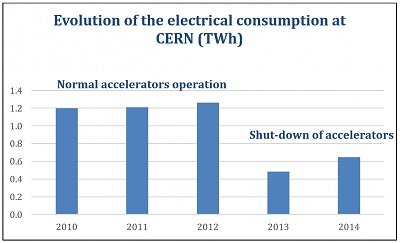CERN consumes the most electricity when its most powerful accelerator, the Large Hadron Collider (LHC), is running, which consumes roughly half of CERN’s electricity. CERN has a typical yearly consumption of about 1.2 terawatt-hours (based on the consumption of the year 2012 when the LHC was running). This figure represents approximately a third of the consumption of the Canton of Geneva.
 Graphic showing CERN’s electrical consumption from 2010 until 2014
Graphic showing CERN’s electrical consumption from 2010 until 2014
A large proportion of the LHC’s electrical consumption keeps the superconducting magnet system at its operating temperatures (-271°C for most of the magnets). This superconducting property means that the energy consumption of the LHC is similar to that of its predecessor, the Large Electron-Positon collider (LEP), which has operated since the 80s, despite the LHC being a much more powerful machine.
Roughly 135 tonnes of liquid helium are necessary to maintain the LHC at very low temperatures. The helium is stored in a closed circuit and when the machine is stopped, the gas is partially stored in special tanks and partially sent back to the supplying companies.